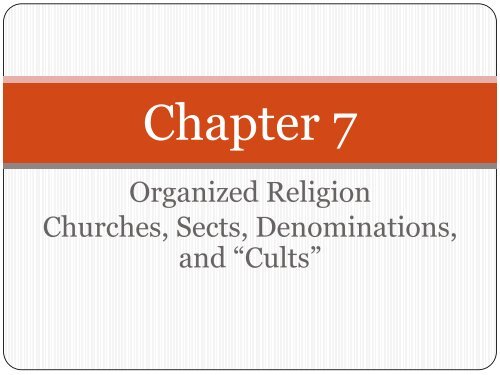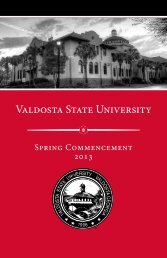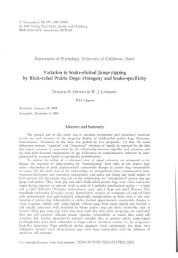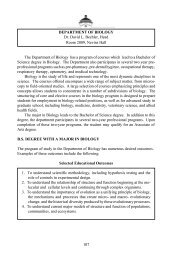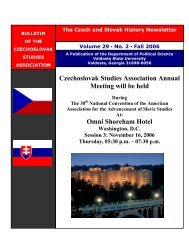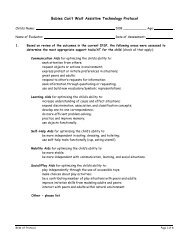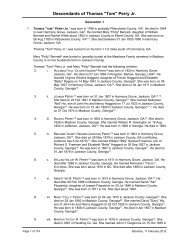Organized Religion
Organized Religion
Organized Religion
You also want an ePaper? Increase the reach of your titles
YUMPU automatically turns print PDFs into web optimized ePapers that Google loves.
Chapter 7<br />
<strong>Organized</strong> <strong>Religion</strong><br />
Churches, Sects, Denominations,<br />
and “Cults”
Outline of the Chapter 7<br />
• Charisma and the Charismatic Leader<br />
• The Routinization of Charisma<br />
• Dilemmas of Institutionalization<br />
• Classifying Religious Organizations<br />
• The Church-Sect Typology<br />
• Social Conditions That Generate Each Type of Group<br />
• New Religious Movements, aka “Cults”
• “Ever since Max Weber first developed the proposition<br />
that New <strong>Religion</strong> Movements generally start out as<br />
cults headed by a charismatic leader, much of the<br />
sociological work in religion has evolved around the<br />
concept of charisma.
Question of the Discussion in Class<br />
• According to the textbook, several scholars<br />
believe that all religious group began as cults<br />
headed by a charismatic leader. Do you think<br />
Jesus (or whoever founded the religious group to<br />
which you adhere or with which you are most<br />
familiar) was a charismatic leader of a new cult or<br />
“NRM (New <strong>Religion</strong> Movement)”?”
The Routinization of Charisma<br />
• The process of routinization (developing stable<br />
routine) is commonly referred to by sociologists as<br />
institutionalization.<br />
• Institutionalization serves both ideal and material<br />
interests of followers and leaders.
The Process of Institutionalization<br />
• It is unplanned; it develops gradually<br />
• It is inherently conservative; it changes, but<br />
slowly.<br />
• It is interdependent; because of this, change in<br />
one institution tends to bring about change in<br />
others<br />
• The statuses, roles, values, and norms associated<br />
with an institution in one society frequently bear<br />
little resemblance to those in another society.<br />
• Open System Theory
The Routinization of Charisma<br />
• The charisma that was once identified with a<br />
personality must be associated with the religious<br />
ideology and with the religious organization.<br />
• The decision making process itself becomes<br />
sacralized as the divinely appointed method of<br />
choosing the successor.<br />
• Method may involve the designation of a<br />
successor by the original leader, some form of<br />
divinely sanctioned and controlled election, the<br />
drawing of lots, hereditary succession, or any one<br />
of a number of other procedures.<br />
• The achievements of several objectives
The Four Types of Leadership<br />
• The Traditional<br />
• The Pope<br />
• The Bureaucratic<br />
• Billy Graham<br />
• The Charismatic<br />
• Jesus<br />
• The Ideological<br />
• Early Christian Leaders (Paul, James, Peter)
Dilemmas of Institutionalization<br />
• A Thomas O’Dea (1961) put it,<br />
• “religion both needs most and suffers most from<br />
institutionalization”<br />
• Although institutionalization is necessary, it tends<br />
to change the character of the movement and to<br />
create certain dilemmas for the religious<br />
organization.
Dilemmas of Institutionalization<br />
• The Dilemma of Mixed Motivation<br />
• The Symbolic Dilemma: Objectification Versus<br />
Alienation<br />
• The Dilemma of Administrative Order: Elaboration<br />
of Policy Versus Flexibility<br />
• The Dilemma of Delimitation: Concrete Definition<br />
Versus Substitution of the Letter for the Spirit<br />
• The Dilemma of Power: Conversion Versus<br />
Coercion<br />
• Institutional Dilemmas and Social Context
Classifying Religious Organizations<br />
• Characteristics of<br />
• Churches<br />
• Sects<br />
• Denominations<br />
• Cults (now usually called New <strong>Religion</strong> Movements)<br />
• Ideal Types by Max Weber
The Church-Sect Typology by Max Weber<br />
The Sect<br />
• Membership is voluntary,<br />
• It is limited to those who<br />
“qualify” for membership<br />
• It involves a substantial<br />
commitment by the<br />
members<br />
The Church<br />
• A group that one is typically<br />
born into rather than<br />
choosing<br />
• Inclusive—that is,<br />
encouraging all members of<br />
the larger society to join<br />
• Minimal commitment is<br />
required to remain a<br />
member
The Church-Sect Typology<br />
• Troeltsch and American theologian H. Richard<br />
Neibuhr, who each wrote much more extensively<br />
on this topic, included Weber’s defining criteria<br />
but expanded the concept to include many other<br />
factors.<br />
• The central characteristic of the church is its<br />
acceptance of the secular order<br />
• The church “compromises” Christian values and makes<br />
accommodations to the secular society<br />
• The sect tends to reject the social order and to<br />
maintain a prophetic ministry
The Church-Sect Typology<br />
• Troeltsch and American theologian H. Richard<br />
Neibuhr, who each wrote much more extensively<br />
on this topic, included Weber’s defining criteria<br />
but expanded the concept to include many other<br />
factors.<br />
• The church are stages in the evolution of a religious<br />
group, adding a new type: the denomination.<br />
• The continuum between sect and church (Figure 7.1)
Single-Variable Models<br />
• A church is a religious group that accepts the social<br />
environment in which it exists.<br />
• A sect is a religious group that rejects the social<br />
environment in which it exists.
Yinger’s Multilinear Evolution Model<br />
• The degree to which the membership policy of the<br />
group is exclusive and selective or open and<br />
inclusive.<br />
• The extent to which the group accepts or rejects<br />
the secular values and structures of society<br />
• The extent to which, as an organization, the group<br />
integrates a number of local units into one<br />
national structure, develops professional staffs,<br />
and creates a bureaucracy.
Yinger’s Multilinear Evolution Model<br />
• Figure 7.3 Yinger’s Schema for Types of Religious<br />
Organization
Social Conditions That Generate Each Type<br />
of Group<br />
• To causes the emergence of new groups by<br />
Niebuhr<br />
• When Christian denominations begin to ignore the<br />
original concern of the faith for poverty and<br />
inequality, sectarian groups are likely to arise.<br />
• Some groups are expressions of ethnic values and<br />
national loyalties.<br />
• Churches and denominations become bogged down<br />
in bureaucratic structures.<br />
• The sectarian movements are sometimes spawned<br />
by a desire for more spontaneity and more<br />
emotional expression in worship.
New Religious Movements, AKA “Cults”<br />
• Figure 7.4 Evolution of Sects and NRMs
New Religious Movements, AKA “Cults”<br />
• Figure 7.5 Social Forces and the Sect-Cult<br />
Transformation
New Religious Movements, AKA “Cults”<br />
• Figure 7.6 The Force Field of Religious Groups: A<br />
Three-Dimensional Model


